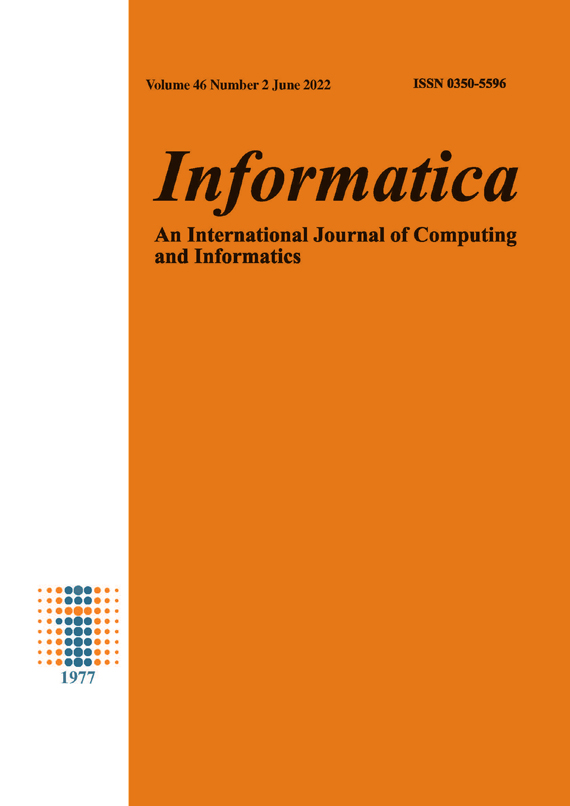A Prestudy of Machine Learning in Industrial Quality Control Pipelines
DOI:
https://doi.org/10.31449/inf.v46i2.3938Abstract
Today’s fast paced industrial production requires automation atmultiple steps during its process. Involving humans during the
quality control inspection provides high degree of confidence that
the end products are with the best quality. Workers involved in
the control process may have an impact on production capacity
by lowering the throughput, depending on the complexity of the
control process at the time the control is carried out, during the
process which is a time-critical operation, or after the process is
completed. Companies are striving to fully automate their quality
control stages of production and it comes naturally to focus on
using various machine learning methods to help build a quality
control pipeline which will offer high throughput and high degree
of quality. In this paper we give an overview of applying several
machine learning approaches in order to achieve an autonomous
quality control pipeline. The applications for these approaches
were used to help improve the quality control pipeline of two of
the biggest manufacturing companies in Slovenia. One of the most
challenging part of the study was that the tests had to be performed
only on a small number of defective products, as is in reality. The
motivation was to test several methods to find the most promising
one for later actual application.
References
D Coupek, A Verl, J Aichele, and Marcello Colledani. Proactive quality control
system for defect reduction in the production of electric drives. In 2013 3rd
International Electric Drives Production Conference (EDPC), pages 1–6. IEEE, 2013.
Anil Mital, M Govindaraju, and B Subramani. A comparison between manual
and hybrid methods in parts inspection. Integrated Manufacturing Systems, 1998.
Jing Yang, Shaobo Li, Zheng Wang, Hao Dong, Jun Wang, and Shihao Tang.
Using deep learning to detect defects in manufacturing: a comprehensive survey
and current challenges. Materials, 13(24):5755, 2020.
Michael Sharp, Ronay Ak, and Thomas Hedberg Jr. A survey of the advancing
use and development of machine learning in smart manufacturing. Journal of
manufacturing systems, 48:170–179, 2018.
Chris J Turner, Christos Emmanouilidis, Tetsuo Tomiyama, Ashutosh Tiwari,
and Rajkumar Roy. Intelligent decision support for maintenance: an overview
and future trends. International Journal of Computer Integrated Manufacturing,
(10):936–959, 2019.
Antje Niederlein, Felix Meyenhofer, Daniel White, and Marc Bickle. Image
analysis in high content screening. Combinatorial chemistry & high throughput
screening, 12(9):899–907, 2009.
Mark-Anthony Bray and Anne E Carpenter. Quality control for high-throughput
imaging experiments using machine learning in cellprofiler. In High Content
Screening, pages 89–112. Springer, 2018.
Carlos A Escobar and Ruben Morales-Menendez. Machine learning techniques
for quality control in high conformance manufacturing environment. Advances
in Mechanical Engineering, 10(2):1687814018755519, 2018.
Ricardo Silva Peres, Jose Barata, Paulo Leitao, and Gisela Garcia. Multistage
quality control using machine learning in the automotive industry. IEEE Access,
:79908–79916, 2019.
Tianqi Chen and Carlos Guestrin. Xgboost: A scalable tree boosting system. In
Proceedings of the 22nd acm sigkdd international conference on knowledge discovery
and data mining, pages 785–794, 2016.
Shaoqing Ren, Kaiming He, Ross Girshick, and Jian Sun. Faster r-cnn: Towards
real-time object detection with region proposal networks. Advances in neural
information processing systems, 28:91–99, 2015.
Jason Wang, Luis Perez, et al. The effectiveness of data augmentation in image
classification using deep learning. Convolutional Neural Networks Vis. Recognit,
:1–8, 2017.
Karen Simonyan and Andrew Zisserman. Very deep convolutional networks for
large-scale image recognition. arXiv preprint arXiv:1409.1556, 2014.
Christian Szegedy, Vincent Vanhoucke, Sergey Ioffe, Jon Shlens, and Zbigniew
Wojna. Rethinking the inception architecture for computer vision. In Proceedings
of the IEEE conference on computer vision and pattern recognition, pages 2818–2826,
Kaiming He, Xiangyu Zhang, Shaoqing Ren, and Jian Sun. Identity mappings
in deep residual networks. In European conference on computer vision, pages
–645. Springer, 2016.
HK Yuen, John Princen, John Illingworth, and Josef Kittler. Comparative study
of hough transform methods for circle finding. Image and vision computing,
(1):71–77, 1990.
Downloads
Published
Issue
Section
License
I assign to Informatica, An International Journal of Computing and Informatics ("Journal") the copyright in the manuscript identified above and any additional material (figures, tables, illustrations, software or other information intended for publication) submitted as part of or as a supplement to the manuscript ("Paper") in all forms and media throughout the world, in all languages, for the full term of copyright, effective when and if the article is accepted for publication. This transfer includes the right to reproduce and/or to distribute the Paper to other journals or digital libraries in electronic and online forms and systems.
I understand that I retain the rights to use the pre-prints, off-prints, accepted manuscript and published journal Paper for personal use, scholarly purposes and internal institutional use.
In certain cases, I can ask for retaining the publishing rights of the Paper. The Journal can permit or deny the request for publishing rights, to which I fully agree.
I declare that the submitted Paper is original, has been written by the stated authors and has not been published elsewhere nor is currently being considered for publication by any other journal and will not be submitted for such review while under review by this Journal. The Paper contains no material that violates proprietary rights of any other person or entity. I have obtained written permission from copyright owners for any excerpts from copyrighted works that are included and have credited the sources in my article. I have informed the co-author(s) of the terms of this publishing agreement.
Copyright © Slovenian Society Informatika








